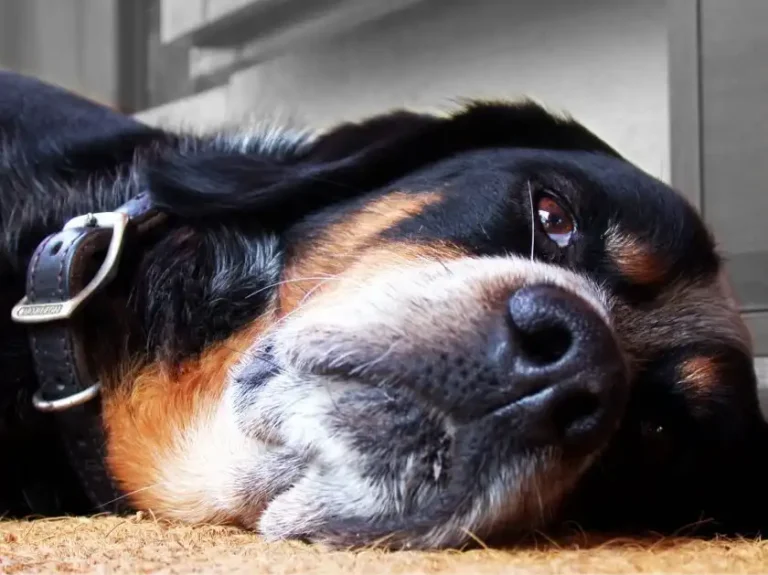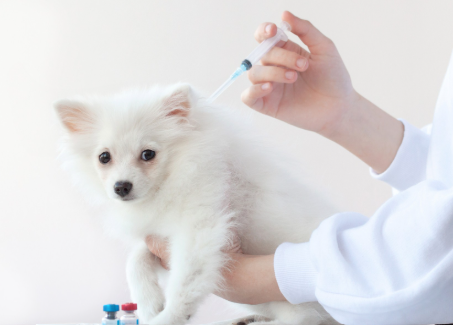Heat period in bitches
Although your dog’s heat is a completely natural process, her strange behavior, irritation over stains on the new carpet or fear of an unwanted pregnancy cause concern for many dog owners. Find out what you need to know about your dog’s heat and how you and your dog can get through the heat without stress here.

Many dog owners find their bitch’s heat a nightmare. They barricade themselves at home, avoid long walks in the park where many male dogs “lurk” on the bitches, and panic-stricken, place old bed sheets over beds and furniture to avoid unsightly stains. After all, furniture is expensive and most dog owners have little desire for an unwanted pregnancy.
Take it easy: With a few tips and tricks, you can get through this phase without any problems and not have to fear unwanted family additions. The more you know, the better: The better informed you are about what happens during the heat and the changes in your bitch related to it, the more stress-free you will experience and be able to prepare for this time.
What you should know about heat in bitches
The heat period – also called the heat period – refers to the fertile phase (heat phase) of the female dog’s sexual cycle. The female dog’s body changes, hormones are released and behavior is affected. This natural process occurs in all female dogs that have reached sexual maturity.
As with humans, the onset of puberty, and the associated onset of sexual maturity, is also very variable in tippets. When the heat comes for the first time, differs from bitch to bitch. The decisive factor for the timing of the first “menstruation” is that the bitch has grown and has reached her full body size.
While small female dogs have their heat at 6 months, bitches of large breeds, which reach sexual maturity much later, often only experience this phase at the age of two years. Just as variable as the time of sexual maturity are the intervals between heats. Bitches of small breeds can become pregnant every four months, dogs of the archetypal Basenji, Thai Ridgeback or Dingo only have one heat per year.
The four phases of the menstrual cycle
Although the interval and duration of the heat period vary considerably, the course of the heat phase is the same in all bitches. The heat period is divided into four phases.
Proestrus (pre-estrus):
When proestrus begins can usually be determined quite accurately because it is accompanied by visible changes in the bitch. The vulva swells and a bloody discharge comes from the vagina. This phase usually lasts nine days, but here too it is not uncommon for fluctuations of between 3 and 17 days.
The amount of bloody discharge also varies from dog to dog. While it is barely visible in one bitch, others bleed so heavily that owners have to worry about red stains on furniture and carpets. Another sign that proestrus has begun is the increased interest of the male dog, who suddenly cannot stay away from the bitch.
Although the bitch is not yet fertile at this time, she already spreads a very “seductive” scent. In this phase, however, she usually reacts very capricious and dismissive to the approaches of her male suitors. She barks, moves away and may also show her teeth when a male dog becomes too intrusive.
Estrus (heat):
During the estrus phase, the bitch abandons her repulsive behavior – she becomes open and interested in the male dog’s advances. This is a clear sign that things are getting “dangerous” now, because now the bitch is ready to mate and fertile. When a male dog approaches, she willingly stands still and puts her tail to the side.
This phase, which also lasts an average of nine days, is therefore also called “standing heat”. During standing heat, several ovulations occur. The swelling of the vulva decreases somewhat, the discharge from the vagina becomes more watery and sometimes more mucous. If mating occurs during these days, the probability of fertilization is high.
Metoestrus (post-estrus):
About nine days after the heat, the metoestrus phase, the post-heat, begins. The symptoms of the heat period, such as the swollen vulva and the watery discharge, gradually disappear. Externally, there are almost no signs of a heat period anymore, but in the bitch’s body, hormones cause one or another change.
Regardless of whether fertilization has occurred or not, the corpus luteum produces the hormone progesterone, which ensures that the embryo attaches to the uterus and grows. It is not until nine to twelve weeks later that the corpus luteum, which has formed after ovulation, breaks down again. The progesterone level, which thus decreases, triggers the hormone prolactin. The release of prolactin stimulates milk production, which in some bitches leads to estrus.
Anoestrus (resting phase):
After the weeks of major hormonal changes, the sex hormones regulate themselves back to normal. Progesterone stays at one level, estrogen levels show only small fluctuations. This resting phase is called anoestrus. It lasts for several weeks to months and ends with the beginning of prooestrus, the next heat period. During this time, the bitch shows no signs of a heat period.
What is special about the first term?
The bitch’s first heat during puberty often differs from this fixed course. It is not uncommon for the first time to occur a so-called “silent heat” where, despite the hormonal changes during the heat, there are no external signs such as discharge. In this case, dog owners may not even be aware that their bitch is having her first heat. This is often the case with the breeds American Staffordshire Terrier, Beagle, Cocker Spaniel or Miniature Pinscher.
The so-called “split estrus” is also not uncommon in young bitches. In this case, typical signs of a proestrus period first appear, such as discharge, which subsequently does not lead to an estrus phase in which the bitch is ready for mating, but subsides completely. Only after a few days or weeks does the bitch show signs of preestrus again, now with a subsequent estrus.
When is a menstrual period disrupted?
If your adult bitch does not have a heat cycle, this may be caused by a disorder of ovarian function or other diseases such as low metabolism or adrenal hyperfunction. In this case, your bitch should be examined by a veterinarian to be on the safe side. The same applies if the heat cycle lasts extremely long, i.e. the bloody discharge lasts more than three weeks, or the heat cycle is very short, in other words if the proestrus and estrus combined are shorter than ten days.
Do dogs go through menopause?
Unlike us humans, dogs do not have menopause. Menopause, where menstruation does not occur, does not exist in our four-legged friends. The heat period in bitches therefore lasts for life. However, some bitches older than 7 years only have their heat period once a year. The heat intervals may therefore become longer with age – but the heat period will not disappear.
How do I discover my bitch’s fertile days?
The fertile period during which the bitch is ready to mate usually lasts five to six days. However, because the transitions from phase to phase are fluid, the “days of heat” cannot always be determined unambiguously. One clue is the change in the color of the blood from dark red to a light, liquid discharge.
However, this is not 100% certain either, because there are also bitches who mate even if the blood is still dark red. Another possibility for determining this heat phase is a test of the so-called tolerance phase. During standing heat, the bitch lets the male dog have free rein, she lifts her tail to the side, the vulva lifts upwards.
When the bitch is scratched in the area between the vagina and the anal opening, this tolerance phase can be detected – but this is not an unambiguous sign either, because there are bitches who react to this reflex even outside of heat.
You can only get accurate information about the fertile days from your veterinarian, who can determine the time of ovulation. Once you have known for a while how many days after the heat actually begins, this will also be the same time for future heat cycles. It is important that you find out when the pre-heat has started. Only in this way can the days until the next estrus be counted.
How do I prevent a pregnancy?
Although you cannot determine your bitch’s heat phase with absolute certainty, there are signs that suggest that she is in heat. At the latest when the bleeding becomes more watery and your bitch stops when approached by her male suitors, you should be careful. As a rule, in this situation you still have enough time to separate the two dogs from each other. Most male dogs do not attack the bitch directly, but start with “foreplay”.
But of course there are also dogs that go straight to the point – in this case it is important that you intervene at the right time. Give your bitch the command to sit or lie down, and position yourself behind her. Keep the male dog at a distance and wait until his owner puts the leash on his dog and walks away with him.
To avoid such stressful situations right from the start, you should take a few points into account during the heat. If you are going out, it is best to do this when there are no other dogs outside, and you should avoid green areas with many dogs running around freely. Only let your bitch off the leashduring the heat when you are sure she is following you, and put her on the leash immediately when you see another dog.
Also try to entertain your bitch with intense playduring walks. Also, make sure at home that lovesick male dogs from the neighborhood cannot run onto your property. It is a good idea to keep the front door and garden gate closed.
Should my bitch be spayed?
To avoid the stress of the heat period, many dog owners today take advantage of the option of spaying. While sterilization ensures that the bitch no longer has puppies but still undergoes the hormonal changes of the cycle, castration prevents the heat period completely.
There are certainly many advantages to this medical procedure. Because the bitch often becomes calmer and no longer bleeds. In addition, this way you can also significantly reduce the risk of certain tumors and cancers.
However, there is also a downside to this. Spayed bitches often suffer from obesity, and the risk of incontinence increases with age. In the cocker spaniel breedand Irish Setter, after castration, a changed coat structure was also noted, which leads to more tangles and therefore requires more care. Before deciding to castrate your bitch, you should carefully consider the advantages and disadvantages, and consult with your breeder or veterinarian.






